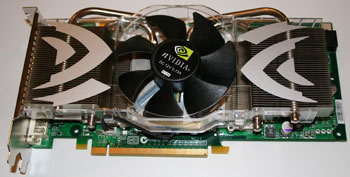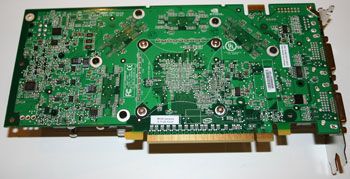GeForce 7900 GTX - Reference Board Exam
The NVIDIA GeForce 7900 GTX reference board is outwardly identical to GeForce 7800 GTX 512. The multi-piece copper and aluminium cooler construction, 92mm centrally mounted fan and quad heatpipes all bear that out. Each heatpipe has around 35W of capacity, making the cooler capable of 140W peak heat output management, and with the cooler just as quiet as with GTX 512, it can manage the maximum 120W load for 7900 GTX @ 650MHz in relative silence.While the cooler doesn't move all the heat produced to the outside of the chassis, after exchange to air, it does at least move some, minimising (to an extent) the heat load to be secondarily managed by your chassis. The cooler looks likely to be a popular one, NVIDIA's AIB partners seemingly likely to make use of it en masse. It's largely a wise choice, too. Here's the board, front and back.
Obviously dual-slot, the product needs power fed to it via an external source and so accepts that via the usual 6-pin PCI Express power connector present at the top right. Both DVI ports are able to drive dual-link displays, such as the popular Dell 3007FWP, and the fan is thermostatically controlled.
It's a large board, and somewhat heavy due to the cooler assembly, but it's no more unweildy than products that precede it. The increased clock rate due to 90nm is paired with lower heat output and power requirements by the same token, so the same PCB constraints apply, and the thermal output is within the old limits of the 550MHz GTX 512.
Naked, you can see the 8 Samsung BJ11 GDDR3 DRAM devices positioned around the chip package, for 512MiB in total. The small core should be evident, especially when compared to something like R520, R580 or NVIDIA's own G70. A smaller chip means more per TMSC 300mm wafer, and with each wafer costing largely the same regardless of what process is used, cost is reduced.
The reference board is VIVO capable, using a Philips processor for video input, and it seems likely that all AIBs will carry that to to their retail boards. Flextronics seem to be the sole board manufacturer for 7900 products (at least initially), so board quality will be static across all AIBs, letting those companies compete on thermal solution and performance.
Noise and Thermals
The GeForce 7900 GTX reference board is commendably quiet and easily the best of the current high-end graphics products that use their reference coolers. Indeed, it's largely the best dual-slot cooler HEXUS have seen to date. The card's BIOS controls the fan speed profiles via a controller ASIC, and at no time during testing of the product did the noise become a concern.Nothing changes compared to GeForce 7800 GTX 512, NVIDIA sticking to the old adage, "if it doesn't make Rys bleed from his ears, let's use the cooler again!". Seriously. 7900 GT is plenty different, so let's look at that reference board closely.











